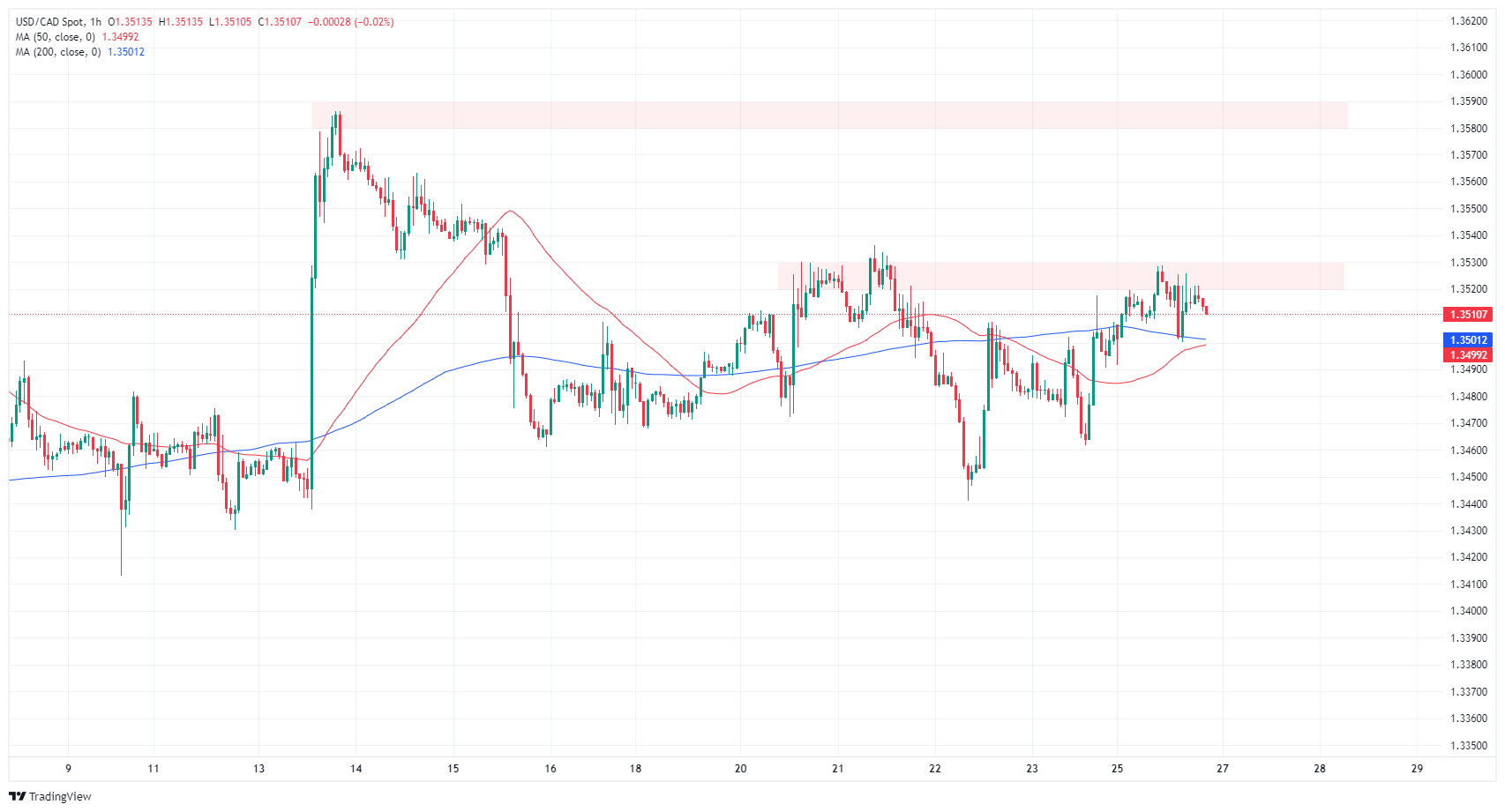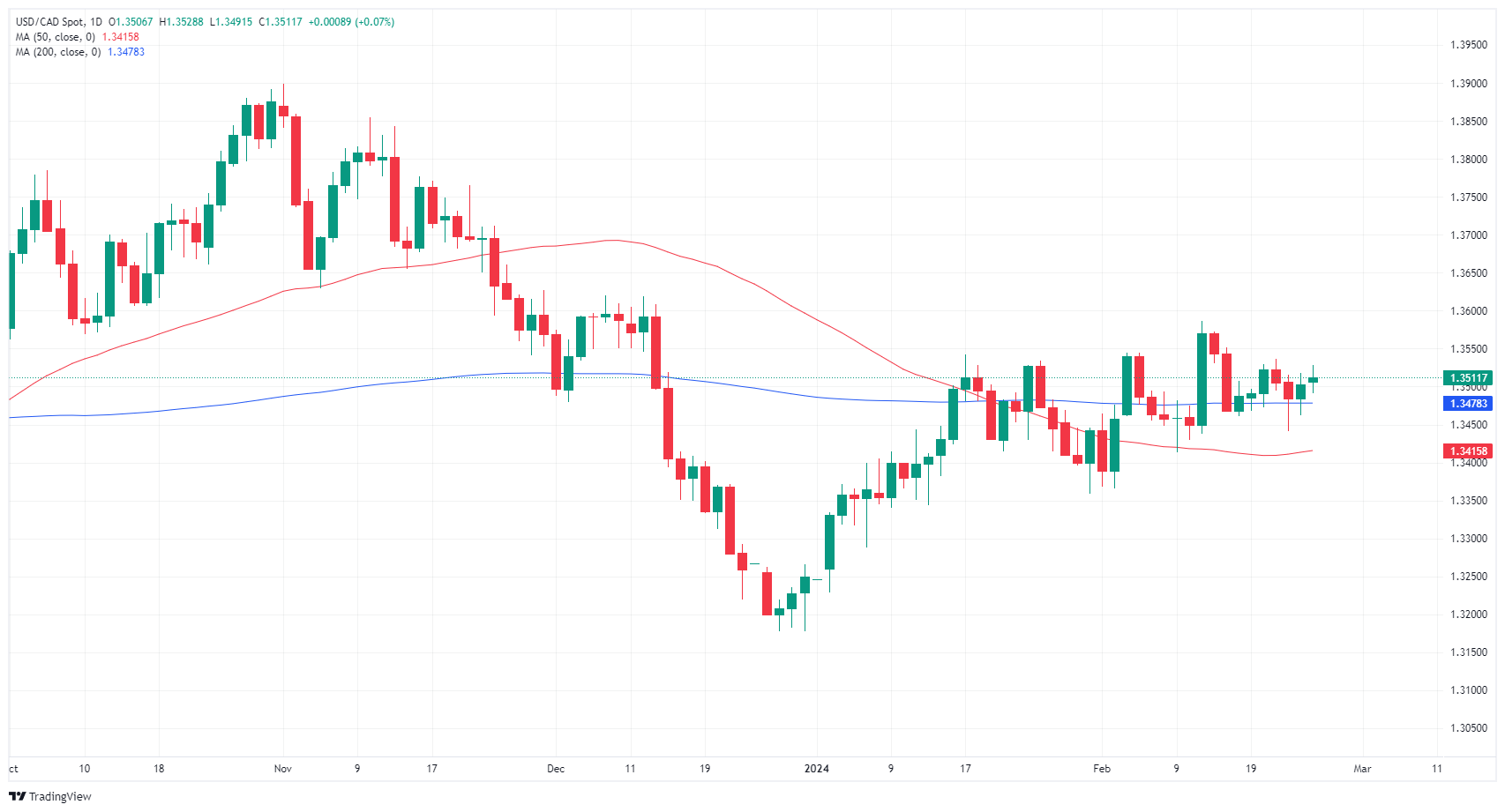- USD/CAD continues Friday’s thin drift near the 1.3500 handle.
- Canada wholesale trade likely fell 0.6% in January.
- US New Home Sales rose 1.5% vs 7.2% previous, Durable Goods due tomorrow.
USD/CAD is stuck in a slow drift near 1.3500 as markets gear up for the week. Economic data remains thin on Monday, and traders will be looking ahead to Tuesday’s US Durable Goods Orders for January, as well as Wednesday’s US Gross Domestic Product (GDP) growth for the fourth quarter.
Canada is predominantly underrepresented on the economic calendar until Thursday’s Canadian GDP Q4 performance. StatCan noted on Monday that Canadian wholesale trade likely fell in January with January’s Canadian manufacturing sales seeing a slight bump.
Daily digest market movers: USD/CAD gears up for a key data week with easy Monday
- According to StatCan Flash Estimate, Canada’s January wholesale trade likely fell by 0.6% MoM, while January manufacturing sales likely rose 0.4% MoM.
- US New Home Sales Change rose 1.5% MoM in January compared to the previous month’s 7.2% (revised from 8.0%).
- US New Home Sales in January 661K versus 680K, previous 651K (revised from 664K).
- Tuesday’s US Durable Goods Orders for January is forecast to decline 4.8% MoM, previous print 0.0%.
- Canada’s Current Account is expected to record -1.25 billion on Wednesday, -3.22 billion previous.
- US fourth-quarter GDP growth forecast to hold steady at 3.3% for the year ended 4Q.
- Canada’s Q4 GDP slated for Thursday, forecast to rebound to 0.8% QoQ versus the previous -1.1%.
Canadian Dollar price today
The table below shows the percentage change of Canadian Dollar (CAD) against listed major currencies today. Canadian Dollar was the strongest against the Australian Dollar.
| USD | EUR | GBP | CAD | AUD | JPY | NZD | CHF | |
| USD | -0.26% | -0.06% | 0.03% | 0.43% | 0.16% | 0.22% | -0.08% | |
| EUR | 0.25% | 0.19% | 0.28% | 0.68% | 0.42% | 0.47% | 0.17% | |
| GBP | 0.04% | -0.22% | 0.08% | 0.48% | 0.21% | 0.27% | -0.03% | |
| CAD | -0.03% | -0.29% | -0.10% | 0.41% | 0.12% | 0.19% | -0.12% | |
| AUD | -0.45% | -0.70% | -0.49% | -0.40% | -0.27% | -0.21% | -0.51% | |
| JPY | -0.16% | -0.43% | -0.18% | -0.13% | 0.28% | 0.07% | -0.25% | |
| NZD | -0.23% | -0.48% | -0.27% | -0.19% | 0.21% | -0.06% | -0.28% | |
| CHF | 0.06% | -0.20% | 0.01% | 0.09% | 0.50% | 0.22% | 0.29% |
The heat map shows percentage changes of major currencies against each other. The base currency is picked from the left column, while the quote currency is picked from the top row. For example, if you pick the Euro from the left column and move along the horizontal line to the Japanese Yen, the percentage change displayed in the box will represent EUR (base)/JPY (quote).
Technical analysis: USD/CAD sees technical floor near 1.3500 as pair churns
USD/CAD near-term technical action continues to see a sideways grind as investors grapple with picking a meaningful direction. 1.3500 remains a key technical level, keeping intraday bids magnetized to the major price handle. USD/CAD has cycled 1.3500 in a rough sideways channel since February 5.
Daily candlesticks remain stuck to the 200-day Simple Moving Average (SMA) at 1.3478 just beneath 1.3500. USD/CAD remains stuck in the middle ground between December’s lows near 1.3177 and last November’s early peak near 1.3900.
USD/CAD hourly chart
USD/CAD daily chart
Canadian Dollar FAQs
What key factors drive the Canadian Dollar?
The key factors driving the Canadian Dollar (CAD) are the level of interest rates set by the Bank of Canada (BoC), the price of Oil, Canada’s largest export, the health of its economy, inflation and the Trade Balance, which is the difference between the value of Canada’s exports versus its imports. Other factors include market sentiment – whether investors are taking on more risky assets (risk-on) or seeking safe-havens (risk-off) – with risk-on being CAD-positive. As its largest trading partner, the health of the US economy is also a key factor influencing the Canadian Dollar.
How do the decisions of the Bank of Canada impact the Canadian Dollar?
The Bank of Canada (BoC) has a significant influence on the Canadian Dollar by setting the level of interest rates that banks can lend to one another. This influences the level of interest rates for everyone. The main goal of the BoC is to maintain inflation at 1-3% by adjusting interest rates up or down. Relatively higher interest rates tend to be positive for the CAD. The Bank of Canada can also use quantitative easing and tightening to influence credit conditions, with the former CAD-negative and the latter CAD-positive.
How does the price of Oil impact the Canadian Dollar?
The price of Oil is a key factor impacting the value of the Canadian Dollar. Petroleum is Canada’s biggest export, so Oil price tends to have an immediate impact on the CAD value. Generally, if Oil price rises CAD also goes up, as aggregate demand for the currency increases. The opposite is the case if the price of Oil falls. Higher Oil prices also tend to result in a greater likelihood of a positive Trade Balance, which is also supportive of the CAD.
How does inflation data impact the value of the Canadian Dollar?
While inflation had always traditionally been thought of as a negative factor for a currency since it lowers the value of money, the opposite has actually been the case in modern times with the relaxation of cross-border capital controls. Higher inflation tends to lead central banks to put up interest rates which attracts more capital inflows from global investors seeking a lucrative place to keep their money. This increases demand for the local currency, which in Canada’s case is the Canadian Dollar.
How does economic data influence the value of the Canadian Dollar?
Macroeconomic data releases gauge the health of the economy and can have an impact on the Canadian Dollar. Indicators such as GDP, Manufacturing and Services PMIs, employment, and consumer sentiment surveys can all influence the direction of the CAD. A strong economy is good for the Canadian Dollar. Not only does it attract more foreign investment but it may encourage the Bank of Canada to put up interest rates, leading to a stronger currency. If economic data is weak, however, the CAD is likely to fall.
Information on these pages contains forward-looking statements that involve risks and uncertainties. Markets and instruments profiled on this page are for informational purposes only and should not in any way come across as a recommendation to buy or sell in these assets. You should do your own thorough research before making any investment decisions. FXStreet does not in any way guarantee that this information is free from mistakes, errors, or material misstatements. It also does not guarantee that this information is of a timely nature. Investing in Open Markets involves a great deal of risk, including the loss of all or a portion of your investment, as well as emotional distress. All risks, losses and costs associated with investing, including total loss of principal, are your responsibility. The views and opinions expressed in this article are those of the authors and do not necessarily reflect the official policy or position of FXStreet nor its advertisers. The author will not be held responsible for information that is found at the end of links posted on this page.
If not otherwise explicitly mentioned in the body of the article, at the time of writing, the author has no position in any stock mentioned in this article and no business relationship with any company mentioned. The author has not received compensation for writing this article, other than from FXStreet.
FXStreet and the author do not provide personalized recommendations. The author makes no representations as to the accuracy, completeness, or suitability of this information. FXStreet and the author will not be liable for any errors, omissions or any losses, injuries or damages arising from this information and its display or use. Errors and omissions excepted.
The author and FXStreet are not registered investment advisors and nothing in this article is intended to be investment advice.
Recommended content
Editors’ Picks

EUR/USD holds near 1.0300 as traders await US NFP
EUR/USD trades in a tight channel at around 1.0300 in the European session on Friday. However, concerns over US President-elect Trump's policies and hawkish Fed expectations keep the US Dollar afloat ahead of the Nonfarm Payrolls data, capping the pair's upside.

GBP/USD struggles to stay above 1.2300, eyes on US jobs report
GBP/USD finds it difficult to gather recovery momentum after rising above 1.2300 earlier in the day. The pair remains vulnerable amid persistent US Dollar strength and the UK bond market turmoil. The focus now shifts to the US labor market data for fresh directives.

Gold climbs to fresh multi-week high above $2,680 ahead of US NFP
Gold price (XAU/USD) gains some follow-through positive traction for the fourth consecutive day and trades at its highest level in nearly a month above $2,680. Market focus shifts to US labor market data, which will feature Nonfarm Payrolls and wage inflation figures.

Nonfarm Payrolls forecast: US December job gains set to decline sharply from November
US Nonfarm Payrolls are expected to rise by 160K in December after jumping by 227K in November. US jobs data is set to rock the US Dollar after hawkish Fed Minutes published on Wednesday.

How to trade NFP, one of the most volatile events Premium
NFP is the acronym for Nonfarm Payrolls, arguably the most important economic data release in the world. The indicator, which provides a comprehensive snapshot of the health of the US labor market, is typically published on the first Friday of each month.

Best Forex Brokers with Low Spreads
VERIFIED Low spreads are crucial for reducing trading costs. Explore top Forex brokers offering competitive spreads and high leverage. Compare options for EUR/USD, GBP/USD, USD/JPY, and Gold.